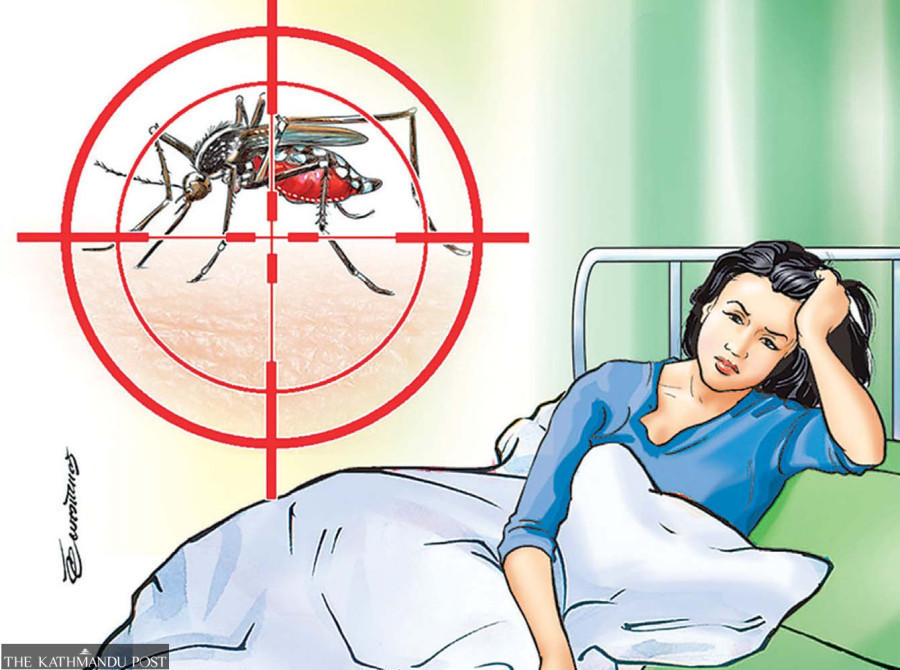Health
Routine dengue virus serotyping to begin soon: Officials
Nepal has detected all four serotypes of the dengue virus—1,2,3,4. Over 1,600 cases have been reported in 73 districts so far this year.
Post Report
In a bid to determine the serotypes of the dengue virus from past and current infections, the Epidemiology and Disease Control Division has been preparing national guidelines.
Officials hope that the new guidelines will require relevant agencies to regularly serotype the deadly virus. Serotypes mean different versions of a virus that can be identified by differences in their proteins.
“We have been carrying out serotyping of dengue virus on an ad hoc basis,” said Dr Gokarna Dahal, chief of the Vector Control Section at the division. “We can expect serotyping of dengue virus on a regular basis once new guidelines are enforced.”
Dengue is a mosquito-borne disease transmitted by female Aedes aegypti and Aedes albopictus mosquitoes. The same vector also transmits chikungunya, yellow fever, and Zika, according to the World Health Organisation.
According to data provided by the division, at least 1,657 people from 73 districts have been infected with the virus since January this year. Among the 73 districts that reported dengue outbreaks, Kathmandu has the highest number of cases with 196, followed by Jhapa with 128, Chitwan with 92, Makawanpur with 73, Okhaldhunga with 57, Tanahun with 56, Bhojpur with 52, and Doti 50 cases.
Public health experts say reported cases could be just the tip of the iceberg, as around 80 percent of those infected are asymptomatic.
There are five serotypes of dengue, numbered 1 through 5.
Nepal has reported four serotypes of dengue virus—DENV-1, DENV-2, DENV-3, DENV-4.
Last year, virus serotypes DENV-1, DENV-2, and DENV-3 were found responsible for the dengue epidemic in the country.
At least 20 persons died, and more than 52,000 were infected by the virus, which had spread to all 77 districts in 2023.
In 2022, a total of 88 people died, and over 54,000 were infected by the virus across the country. During that period, hospitals in the Kathmandu Valley were overwhelmed with dengue patients, and pharmacies ran out of paracetamol, the most widely used medicine to treat fever.
In 2019, the disease killed at least six people and more than 16,000 were hospitalised across the country. The virus had spread to 68 districts at the time.
Entomologists say that regular serotyping of the dengue virus is important. Pathological investigation of the deadly virus helps differentiate the serotypes of past and current infections, which will ultimately help make people aware of the risks.
“People who were infected with one serotype of the dengue virus will not get infected from the same serotype immediately,” said Sishir Panta, an entomologist. “But the risk of severity will be high if he/she is infected with different serotypes. Concerned authorities can tell the people about the serotypes spreading in their communities.”
Experts say the disease will not stop spreading unless the lessons and experiences gained in previous outbreaks are implemented. They say the real number of infections could be several times higher, as the government’s case reporting system is not very effective, and more than 80 percent of the cases are asymptomatic.
Many people infected with dengue show mild symptoms, which do not need any treatment or can be treated with paracetamol at home. Dengue-transmitting mosquitoes breed in clean water and bite people in daylight. Uncovered water tanks and discarded objects such as plastic cups and bottles could be breeding grounds for dengue-carrying mosquitoes.
According to doctors, mild to high fever, severe muscle pain, rashes, severe headache and pain in the eyes are some symptoms of dengue. Doctors advise that those with these symptoms should seek immediate treatment. While there is no specific cure for the disease, early detection and access to proper medical care can lower fatalities.
Nepal reported its first dengue case in a foreigner in 2004 in the Chitwan district. Since then, an increasing number of dengue infections, including major outbreaks, have been reported from many districts.
Though the post-monsoon period is considered the dengue epidemic season, the deadly disease has already become endemic in Nepal, as outbreaks are reported every month, including in the winter months.




 7.12°C Kathmandu
7.12°C Kathmandu













